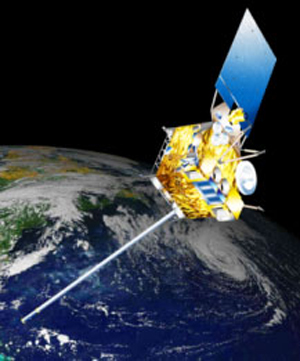As reported in previous stories, the GOES-13 weather satellite experienced many issues in September 2012 that forced NOAA to temporary replace the satellite. GOES-13 was offline for some weeks, and no one knew if it would return. But now it has!
Back in September, GOES-13 experienced a lot of noise, which eventually resulted in the repair of the sounder and imager instruments. In order for GOES-13 to be fixed, NOAA decided to grab the GOES-14 satellite to temporarily replace GOES-13. In fact, during the month of October, NOAA was slowly drifting the GOES-14 satellite into GOES-13’s current position. However, this transition is no longer needed, as GOES-13 – whose function is to provide visible/infrared images and various weather measurements for the eastern U.S. and Atlantic Ocean – is back.

The GOES-13 satellite, which provides regular weather images every 15 minutes, is a valuable tool for meteorologists and climatologists. The geostationary satellite has been providing coverage of the U.S. East Coast since April 14, 2010.
Not only can it produce satellite images both in the visible and infrared channels, but it can also take in and relay back a lot of meteorological information that actually is used in our various weather models, such as the Global Forecast System (GFS) and the European Centre for Medium-Range Weather Forecasts (ECMWF). These are valuable tools that NASA/NOAA use to monitor our entire weather and climate across the globe.
GOES-14 – the temporary satellite that was going to fill in for GOES-13 – had been on a slow drift to move into GOES-13’s position. NOAA now says the GOES-14 Drift Stop Maneuver ended on October 19, 2012 at 1356 UTC.

So, how did NOAA fix GOES-13? The huge problem with fixing the satellite was that trouble stemmed from a motor vibration, which caused a lubricant buildup that obstructed the spinning motion of the filter wheel in the sounder. A team that consisted of NOAA, Boeing, and ITT suppressed the vibration and were able to allow the filter wheel to begin spinning and working correctly. They were able to fix these issues, and improved the overall performance from GOES-13. Read more about the fix from NOAA.
Here’s an excerpt from the full report from NOAA:
Tests of GOES-13 instrumentation have demonstrated the imager and sounder are ready to return to GOES-East operational service. GOES-13 Imager data are nominal and thanks to outgassing activities the noise in GOES-13 Sounder shortwave data has been reduced compared to pre-anomaly levels. The return of GOES-13 to operational service also optimizes the long term continuity of the GOES constellation.
NOAA always has backup plans for satellites in case of issues occur similar to GOES-13. Mary Kicza, assistant administrator of NOAA’s Satellite and Information Service stated:
With severe weather always a threat, NOAA had back-up resources and contingency plans already established, so the critical flow of satellite data was uninterrupted.

Bottom Line: GOES-13 geostationary satellite has been fixed after experiencing issues for the past month. GOES-14 was the temporary satellite that was slowly drifting into position to cover the eastern coast of the United States and parts of the Atlantic ocean. NOAA operates two GOES spacecraft 22,300 miles above the Equator, has an additional GOES in orbital storage mode, and operates the polar operational environmental satellite (POES) program satellites, which fly 540 miles above Earth’s surface, circling near the North and South Poles.











